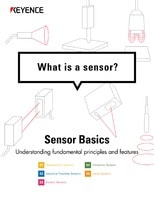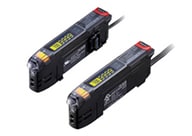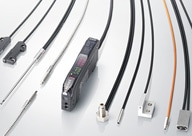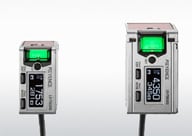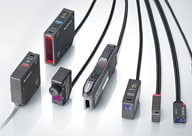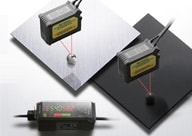Detection based on “Light”
What is a Fiber Optic Sensor?
Sensors come in a wide variety, and each type has strengths and weaknesses. This section provides a detailed look at fiber optic sensors.
Outline
The fiber optic sensor has an optical fiber connected to a light source to allow for detection in tight spaces or where a small profile is beneficial.
Principle and major types

The optical fiber consists of the core and the cladding, which have different refractive indexes. The light beam travels through the core by repeatedly bouncing off the wall of the cladding. The light beam, having passed through the fiber without any loss in light quantity, is dispersed at an angle of approximately 60° and emitted to the target.
The cores are divided into the following types:
Plastic type
The core of the plastic-fiber consists of one or more acrylic-resin fibers 0.25 to 1 mm 0.01" to 0.04" in diameter, encased in a polyethylene sheath. Plastic fibers are light, cost-effective, and flexible which is why they are the most common type of fiber sensor.
Glass type
The glass-fiber consists of 10 to 100 μm 0.39 to 3.94 Mil diameter glass fibers encased in stainless steel tubing. This allows it to be used at high operating temperatures (350°C 662°F max.).
The optical fiber sensors are divided into two categories: thrubeam and reflective. The thrubeam type comprises a transmitter and a receiver. The reflective type, which is a single unit, is available in 3 types: parallel, coaxial, and separate. The 3 are based on the shape of the crosssection of the optical fiber.
| Type | Description |
|---|---|
Parallel |
Generally used for plastic fibers. |
Coaxial |
High-precision type, consisting of a core (transmitter) and surrounding area (receiver). The operating position can remain the same regardless of the direction from which the target enters the detecting area. |
Separate |
This type, containing several 10µm 0.39 Mil glass fibers in diameter, has separate areas for the transmitter and receiver. |
| Type | Description |
|---|---|
Parallel |
Generally used for plastic fibers. |
Coaxial |
High-precision type, consisting of a core (transmitter) and surrounding area (receiver). The operating position can remain the same regardless of the direction from which the target enters the detecting area. |
Separate |
This type, containing several 10µm 0.39 Mil Mil glass fibers in diameter, has separate areas for the transmitter and receiver. |
-
Detection based on “Light”
Method to choose Photoelectric Sensors as to environment
Photoelectric Sensors -
Detection based on “Light”
Features and advantages of Fiber Optic Sensor
Fiber Optic Sensors

